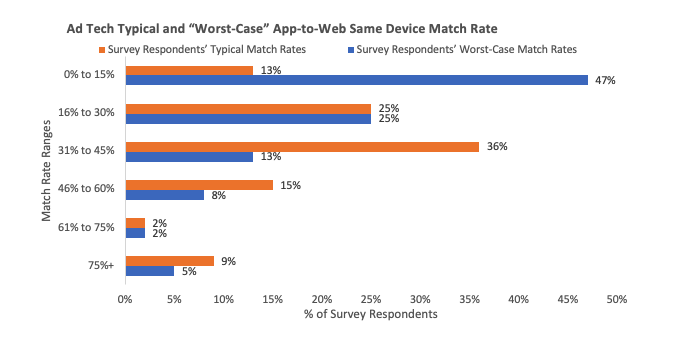One key to successful advertising is showing ads to people at just the right moment. Advertisers understand that the typical smartphone user moves seamlessly between apps and websites throughout the day, and this makes showing ads on both crucial to reaching their audience.
However, connecting the dots between an ad interaction and a conversion across mobile web and apps has been a persistent challenge. Today, many ad tech companies rely on large signed-in user bases or supplemental identity graphs to try to bridge this gap. Yet these methods often deliver low and inconsistent match rates, leaving advertisers struggling to accurately measure their campaign performance.
As consumer privacy protections continue to transform the digital advertising landscape, privacy-preserving solutions are opening new avenues for innovation.
This latest study1 conducted by AdExchanger and Google helps evaluate today’s considerable gap in effectively attributing web conversions back to in-app clicks and views. New technology, such as Privacy Sandbox’s Attribution Reporting API, offers a privacy-preserving approach that natively supports cross-app and web measurement. In addition to the potential to improve current methodology, this technology also provides a durable longer-term solution as the industry continues to evolve.

The app-to-web attribution industry gap
While more than 83% of surveyed ad tech companies are aware of the ability to measure cross-app and web match rates, only 55% currently offer a specific app-to-web attribution measurement solution. In comparison, 78% of agencies and brands say the ability to match clicks and conversions across apps and the mobile web on the same device is, or would be, important to how they measure advertising and plan budgets. These findings show there’s a significant gap in the industry between what advertisers want and what ad tech companies are able to provide.
App-to-web attribution match rates are low – and ad tech’s worst-case campaign match rates are extremely low
Some of this gap may be due to how difficult it is to actually match clicks and conversions across app and web. The survey found that 74% of ad tech providers say their typical match rate for clicks and conversions across apps and the web is less than 45%. And worst-case campaign match percentages are 30% or less, according to 72% of ad tech executives.

Subscribe
AdExchanger Daily
Get our editors’ roundup delivered to your inbox every weekday.
Agencies and brands have also seen low match rates. Their typical app-to-web match rates are similar to ad tech companies, but their worst-case campaign matching is on average even lower, with 88% saying they have seen match rates less than 30%.
Better app-to-web match rates benefit ad tech companies and advertisers
Both ad tech companies and their clients, agencies and brands, see value in better app-to-web matching. Eighty-five percent of ad tech executives believe increasing match rates would drive more revenue, with 52% of executives forecasting annual revenue increases of over $1 million and 13% expecting increases of over $51 million. “Low match rates are a very big concern,” noted an ad tech executive.
Meanwhile, effective measurement across apps and the web is important to agencies and brands, too, especially when it comes to budget planning. In fact, 93% of agencies and brands said they would feel more confident increasing their ad budgets if they could more accurately attribute ad conversions. The same percentage (93%) noted that if match rates across apps and the web increased by 25%, their ROI would improve as well.

Privacy Sandbox’s Attribution Reporting API (ARA) solution offers purpose-built app-to-web attribution
The Attribution Reporting API streamlines app-to-web measurement by performing the matching of an app ad to a web conversion, or vice versa, directly on a person’s device. This means supplemental identity graphs and extensive first-party data are no longer required for accurate attribution. By eliminating this reliance on separate identity solutions, the Attribution Reporting API empowers ad tech companies, advertisers and publishers to measure across apps and the web with greater accuracy and consistency than possible today.
Improving app-to-web match rates is a major opportunity
The ability to optimize app-to-web attribution is a major opportunity for the digital advertising industry. For ad tech companies, improved app-to-web attribution can unlock incremental spend from advertisers as they tap into new opportunities, and better matching supports the needs of all ad tech companies, regardless of their identity graph or first-party data sets. Advertisers also benefit from more effective campaigns, more precise measurement and, ultimately, a greater return on their advertising investments.
Improvements to app-to-web matching, like those provided by Privacy Sandbox’s Attribution Reporting API, enable a more efficient ad tech ecosystem that prioritizes consumer privacy. Anyone can get started with the Attribution Reporting API today, available now on both Chrome and the latest versions of Android.
| 1About the Survey and Respondents: A survey of ad tech companies, agencies and brands was conducted by Google and AdExchanger to quantify industry metrics and highlight issues related to optimizing app-to-web attribution match rates. The survey respondents are primarily agencies (30%) and ad tech companies (28%). An additional 8% of the respondents work for DSPs, while 6% work for SSPs, and 2% are with DMPs. Forty percent of the respondents are C-levels or EVP/VPs. Thirty-two percent are with companies with over $100 million in revenue. The survey was conducted in May and June 2024 and received 211 responses. |





